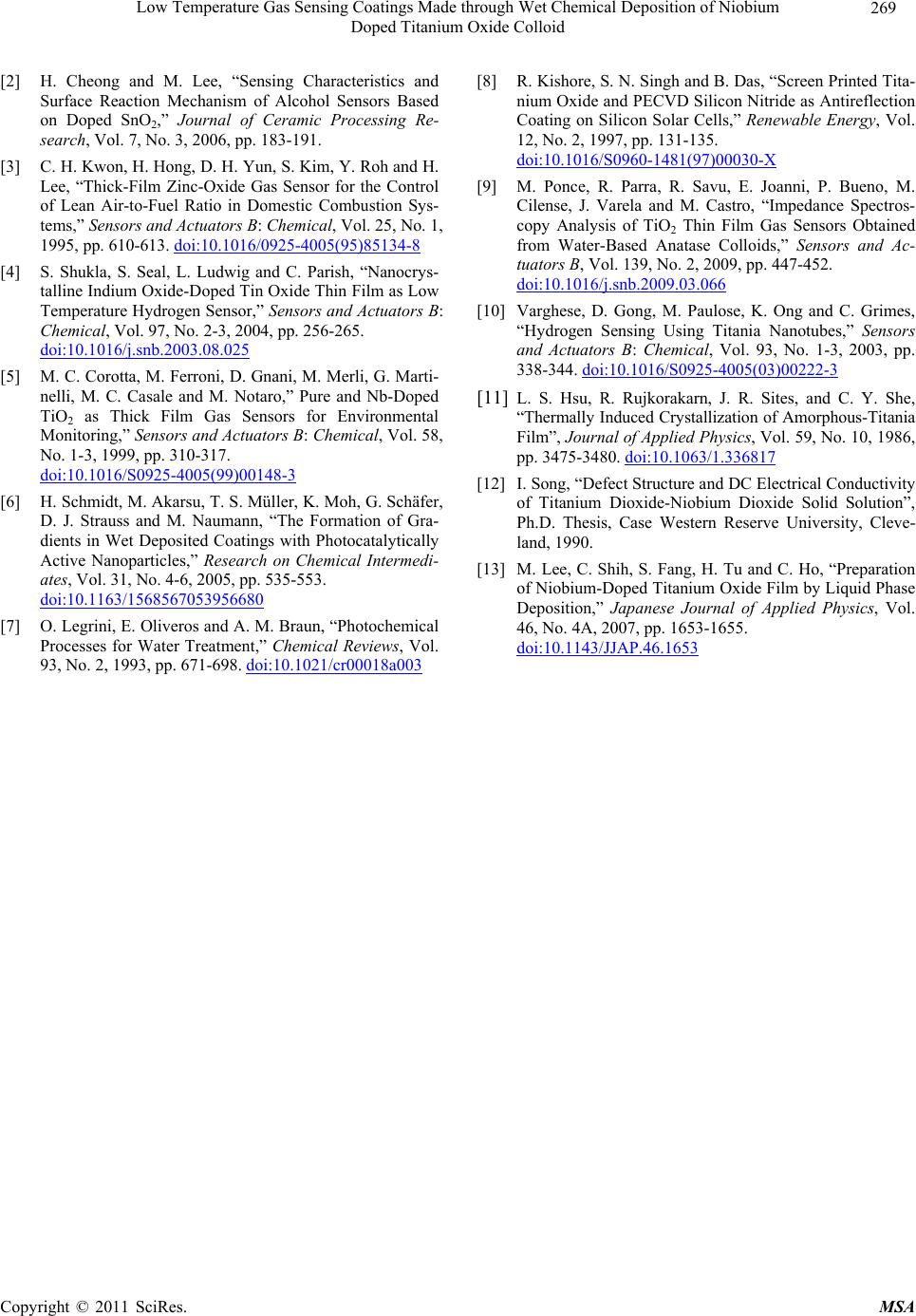
Low Temperature Gas Sensing Coatings Made through Wet Chemical Deposition of Niobium 269
Doped Titanium Oxide Colloid
[2] H. Cheong and M. Lee, “Sensing Characteristics and
Surface Reaction Mechanism of Alcohol Sensors Based
on Doped SnO2,” Journal of Ceramic Processing Re-
search, Vol. 7, No. 3, 2006, pp. 183-191.
[3] C. H. Kwon, H. Hong, D. H. Yun, S. Kim, Y. Roh and H.
Lee, “Thick-Film Zinc-Oxide Gas Sensor for the Control
of Lean Air-to-Fuel Ratio in Domestic Combustion Sys-
tems,” Sensors and Actuators B: Chemical, Vol. 25, No. 1,
1995, pp. 610-613. doi:10.1016/0925-4005(95)85134-8
[4] S. Shukla, S. Seal, L. Ludwig and C. Parish, “Nanocrys-
talline Indium Oxide-Doped Tin Oxide Thin Film as Low
Temperature Hydrogen Sensor,” Sensors and Actuators B:
Chemical, Vol. 97, No. 2-3, 2004, pp. 256-265.
doi:10.1016/j.snb.2003.08.025
[5] M. C. Corotta, M. Ferroni, D. Gnani, M. Merli, G. Ma rti-
nelli, M. C. Casale and M. Notaro,” Pure and Nb-Doped
TiO2 as Thick Film Gas Sensors for Environmental
Monitoring,” Sensors and Actuators B: Chemical, Vol. 58,
No. 1-3, 1999, pp. 310-317.
doi:10.1016/S0925-4005(99)00148-3
[6] H. Schmidt, M. Akarsu, T. S. Müller, K. Moh, G. Schäfer,
D. J. Strauss and M. Naumann, “The Formation of Gra-
dients in Wet Deposited Coatings with Photocatalytically
Active Nanoparticles,” Research on Chemical Intermedi-
ates, Vol. 31, No. 4-6, 2005, pp. 535-553.
doi:10.1163/1568567053956680
[7] O. Legrini, E. Oliveros and A. M. Braun, “Photochemical
Processes for Water Treatment,” Chemical Reviews, Vol.
93, No. 2, 1993, pp. 671-698. doi:10.1021/cr00018a003
[8] R. Kishore, S. N. Singh and B. Das, “Screen Printed Tita-
nium Oxide and PECVD Silicon Nitride as Antireflection
Coating on Silicon Solar Cells,” Renewable Energy, Vol.
12, No. 2, 1997, pp. 131-135.
doi:10.1016/S0960-1481(97)00030-X
[9] M. Ponce, R. Parra, R. Savu, E. Joanni, P. Bueno, M.
Cilense, J. Varela and M. Castro, “Impedance Spectros-
copy Analysis of TiO2 Thin Film Gas Sensors Obtained
from Water-Based Anatase Colloids,” Sensors and Ac-
tuators B, Vol. 139, No. 2, 2009, pp. 447-452.
doi:10.1016/j.snb.2009.03.066
[10] Varghese, D. Gong, M. Paulose, K. Ong and C. Grimes,
“Hydrogen Sensing Using Titania Nanotubes,” Sensors
and Actuators B: Chemical, Vol. 93, No. 1-3, 2003, pp.
338-344. doi:10.1016/S0925-4005(03)00222-3
[11] L. S. Hsu, R. Rujkorakarn, J. R. Sites, and C. Y. She,
“Thermally Induced Crystallization of Amorphous-Titania
Film”, Journal of Applied Physics, Vol. 59, No. 10, 1986,
pp. 3475-3480. doi:10.1063/1.336817
[12] I. Song, “Defect Struct ure and DC Electrical Conductivity
of Titanium Dioxide-Niobium Dioxide Solid Solution”,
Ph.D. Thesis, Case Western Reserve University, Cleve-
land, 1990.
[13] M. Lee, C. Shih, S. Fang, H. Tu and C. Ho, “Preparation
of Niobium-Doped Titanium Oxide Film by Liquid Phase
Deposition,” Japanese Journal of Applied Physics, Vol.
46, No. 4A, 2007, pp. 1653-1655.
doi:10.1143/JJAP.46.1653
C
opyright © 2011 SciRes. MSA